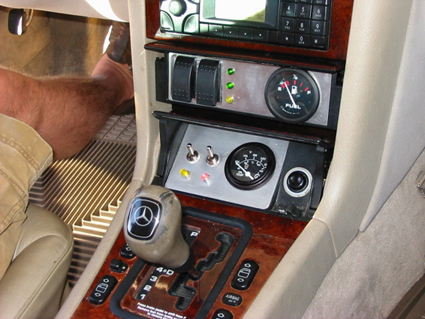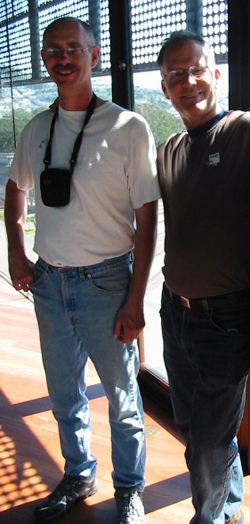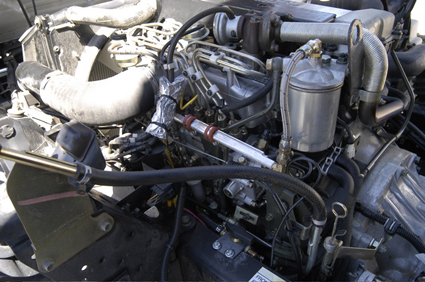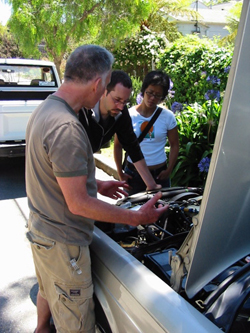Ed Beggs grew diesel fuel in Ontario on his Canadian farm for years without realizing it. He called it soybeans back then. Today the British Columbia resident knows better. He likes to call it premium diesel fuel. Why the paradigm shift? Because Ed and his U.S. business partner, Craig Reece, operate PlantDrive, one of the premier companies producing Straight Vegetable Oil/Waste Vegetable Oil (SVO/WVO) conversion kits and components for fueling diesel engines with straight plant oil.
Conversion kit is really a misnomer. Auxiliary fuel system is more accurate since the vehicle gets an additional fuel line and fuel tank. The modified vehicle totes plant oil in a second tank (the stock diesel fuel tank is untouched in most systems) and the auxiliary fuel system is heated while the stock fuel line is left intact. Plant oils like soy and canola, which are similar to regular diesel fuel in that they are liquid at room temperature and have similar BTU content, are about 10-15 times more viscous than No. 2 diesel. Heat is required to reduce the viscosity of the SVO/WVO to a level the diesel engine can accept.
How does it work once the kit is installed? The modified diesel vehicle starts up on a starter fuel of either petroleum diesel or biodiesel drawn from the stock fuel tank, and then switches to the heated vegetable oil fuel once the engine is up to normal temperature.

Using vegetable oil as a fuel has several compelling benefits. It is less expensive than diesel fuel; it is renewable; it displaces imported petroleum and burns slightly cleaner than petroleum diesel. Because of its low volatility (among other factors), SVO/WVO cannot be used in gasoline engines. So no peanut oil fuel for your old Ford Pinto. If you'd like to learn more about how to modify your diesel to perform this magic trick, check out my book, Sliding Home: A Complete Guide to Driving Your Diesel on Straight Vegetable Oil. Many of the SVO conversion kit companies in the U.S. sell it. OK, shameless commerce division signing off. Back to PlantDrive.
PlantDrive operates out of two locations: British Columbia, Canada and Berkeley, California. All kits and components are sent from the U.S. facility. About 80 percent of PlantDrive customers are from the U.S. with the balance from Canada and other countries. The company was formerly known as Neoteric Biofuels. I suspect the name change was due to prospective customers running to their dictionaries to look up the meaning of neoteric. I know I was stumped. It means recent, new, modern, in case you were curious.
Academic Beginnings
PlantDrive began with a personal epiphany. Ed Beggs was working on a Master of Science degree in Environment and Management and came to a crossroads in 2000. He wondered if he should do a thesis on the design of sustainable communities or design a system to run a diesel engine on plant oil? Ed came down on the side of the diesel project, and a 1984 VW Jetta diesel with a hose in hose design was the test rig for Ed's system. Many canola oil-fueled kilometers later, a chance phone conversation with a family friend brought Henry Mackaay, an experienced machinist and Ed's first business partner, into the fold.

"After I mentioned I was driving my diesel on vegetable oil, there was a long pause at the other end of the line," Ed said. "The next thing Henry said was 'I'll be right over.' We started out helping local friends then started selling parts from a modest website. Soon we graduated to complete kits and we were off and running. Craig Reece came into the picture as a regular customer not too long after. When Henry decided to leave to pursue other interests in 2003, I almost immediately thought of Craig as his successor. Craig and I came to an agreement without ever having met face-to-face. With some people, you just know it's going to work out."
Ed dabbled in homebrew biodiesel production for a time while he was developing his SVO system. His first biodiesel processor was a vintage wringer-type washer he picked up for a $1 at a flea market. Eventually, the economics of SVO (it's cheaper and safer than making biodiesel) won out.
Grow or Go
Things move fast in the biofuels universe. Driven by Ed and Craig's desire to push the innovation envelope, PlantDrive has traditionally been one of the frontrunners. Their experience installing innumerable systems (Ed at his shop in Canada and Craig here in the States) sparks plenty of ideas - some discarded as unworkable, some developed into new products or installation techniques and some "still in the lab".
They were first to recommend and offer the well-respected Vormax filter unit that is now offered by other SVO kit vendors. Previous filters were often small and based on stock VW diesel filters - inexpensive, and prone to clog early, often and at inconvenient times. The Vormax sports a settling bowl and a larger filter mounted on a coolant heated aluminum head. Craig "discovered" the Hotstk/Hotfox coolant heat exchangers and was one of the first to tout their use in SVO/WVO fuel systems. Many early systems used coiled copper pipe or other designs that were clearly outclassed by the mass-produced Hotsk (from Webb) or Hotfox (from Arctic Fox). Craig said, "Why reinvent the wheel when the wheel [Hotstk/Hotfox] has been working well for truckers who, as a group, are a demanding lot and particular about their equipment."
From humble beginnings, Ed's original design for an electric heated fuel line unit, the Vegtherm™, has proven to be a popular item in the catalog. "I used a 12 amp draw glow plug in a machined aluminum tube. I found that my diesel was cooling down on long downhill runs and I wanted a device to keep the fuel temperature up." The original Vegtherm™ was designed for 4 cylinder VW TDI and Mercedes 5 cylinder diesel flow rates, and Ed and Craig developed a "mega" was developed as customers with V-8 diesels like the Dodge Cummins, Ford Powerstroke and Chevy/GM Duramax started knocking on PlantDrive's door. While the standard or mega model is included in PlantDrive kits, Vegtherms are often purchased al a carte by diesel owners creating their own SVO system with parts from various sources. The Vegtherm™ success gave rise to other oil-heating experimentation that resulted in a recently introduced SVO filter heater device, the Overnighter™. It is a 12V heater inside the filter housing that keeps the SVO warm overnight so it flows better on cold mornings. The Overnighter™ switches itself off if battery voltage drops below a set level. Both Ed and Craig believe in keeping the vegetable oil fuel toasty - the hotter, the better.
Even though Ed is no longer farming, he is fluent in "farm-ese" and knows a great deal about processing feedstock into usable oil. One little tidbit he mentioned during our interview was the fact that for many years the majority of corn and soy in the U.S. has been going to industrial (i.e. non-food) uses. Interesting fact, in light of the current biofuels debate over food vs. fuel.
Marketing Plant Oil Fueling
Despite increasing popularity, SVO/WVO fueling kits don't sell themselves. Promotion and marketing is necessary. Of course, having a cool website is de rigueur. Another time-tested approach is to get face-to-face with prospective customers. "In the early days, Craig and I traveled to alternative energy fairs to do demonstrations and sometimes a complete installation of our system. With the popularity of the Internet, we aren't doing as many of these events as we used to." PlantDrive kits and components are sold throughout Canada and several other foreign countries. In the U.S., buyers hail from any of the states, but Ed said, "There are pockets - like Seattle, Vermont, Texas and college towns - where we've sold more kits than other areas of the country."
Another technique is to highlight high profile customers like fleet operators who have gone the veggie fuel route. PlantDrive has an impressive number of these. One of them is the Alameda County Board of Supervisors Waste Management Program. The County of Alameda - which includes Oakland and Berkeley - operates Hazardous Waste Disposal centers, and actively encourages homeowners to bring their waste cooking oil in instead of dumping it down the drain. The manager of the department had heard that vehicles could run on WVO, realized it was a waste of taxpayer dollars to have the WVO hauled from the county's facilities by oil renderers, and contacted Craig. The county has converted a Dodge pickup and a 2002 Jetta, and are planning on replacing the County's fleet of Prius hybrids with more converted Jettas. Converting bigger trucks is in the works.

Customer service is tricky when you're on a phone with someone hundreds of miles away trying to diagnose a problem or explain a procedure. Craig tends to be the "voice of Plantdrive". He spends a good deal of his waking hours on the phone walking customers through SVO kit installation or operation problems (and more than a few wee hours of the morning, feet propped up, laptop ablaze, returning email inquiries). "We get customers of widely varying skill levels. Some are master mechanics and some ... well, some aren't! We do our level best to treat each customer with courtesy and respect. We don't want to be 'box pushers'. We are committed to making sure every customer has the best possible experience - installing our SVO kits and operating their converted vehicles."
Ed and Craig have been in business long enough to observe a shift in the market. "We're seeing more of what I would describe as a 'main stream' kind of customer. Years ago, the typical customer was a rabid environmentalist who had an old VW or Mercedes diesel he or she had purchased for $1000 and diving for WVO in a restaurant dumpster was a grand adventure. The customer didn't mind a little sweat equity to join the SVO club. Now we're seeing more customers with newer diesels like the Chevy Duramax who are interested in cutting fuel costs, who like the idea of using a domestically produced fuel, but are somewhat less passionate about the environmental benefits. They also expect a certain level of convenience. They're less likely to be enthused about going through the mess and effort of collecting their own oil and would like the manual switching and purging necessary with the standard SVO fueling system to be more 'idiot-proof' because the vehicles are being driven by several operators, not just one driver. I'm generalizing, of course."
To respond to the need for convenient operation, PlantDrive began offering a hands-off, automatic switching unit called SmartVeg™ to customers interested in a system that didn't rely on the driver's judgment about when to switch to SVO from the starter fuel (diesel or biodiesel) and when to purge the system at the end of the trip. The SmartVeg™ unit was developed by a British firm and has been sold in England and Europe for several years. PlantDrive is the exclusive U.S. and Canadian distributor. PlantDrive is also the sole source for getting SVO tested to see if it meets the European "vegetable oil fuel" standard, which based on rapeseed (i.e. canola) oil.

What's Next?
During my visit to the PlantDrive headquarters in California, I was shown a couple of prototypes of new products. While I'm sworn to secrecy about the details, I can say that the engineering is first rate and they prompted me to think, "It's so obvious, what didn't I think of it?" Whenever I find myself thinking like that, I know I'm in the presence of a quality product. So flip your flux capacitor over to PlantDrive every so often. You just may discover the future of veggie oil fueling materializing in the present.
Conversion kit is really a misnomer. Auxiliary fuel system is more accurate since the vehicle gets an additional fuel line and fuel tank. The modified vehicle totes plant oil in a second tank (the stock diesel fuel tank is untouched in most systems) and the auxiliary fuel system is heated while the stock fuel line is left intact. Plant oils like soy and canola, which are similar to regular diesel fuel in that they are liquid at room temperature and have similar BTU content, are about 10-15 times more viscous than No. 2 diesel. Heat is required to reduce the viscosity of the SVO/WVO to a level the diesel engine can accept.
How does it work once the kit is installed? The modified diesel vehicle starts up on a starter fuel of either petroleum diesel or biodiesel drawn from the stock fuel tank, and then switches to the heated vegetable oil fuel once the engine is up to normal temperature.

Using vegetable oil as a fuel has several compelling benefits. It is less expensive than diesel fuel; it is renewable; it displaces imported petroleum and burns slightly cleaner than petroleum diesel. Because of its low volatility (among other factors), SVO/WVO cannot be used in gasoline engines. So no peanut oil fuel for your old Ford Pinto. If you'd like to learn more about how to modify your diesel to perform this magic trick, check out my book, Sliding Home: A Complete Guide to Driving Your Diesel on Straight Vegetable Oil. Many of the SVO conversion kit companies in the U.S. sell it. OK, shameless commerce division signing off. Back to PlantDrive.
PlantDrive operates out of two locations: British Columbia, Canada and Berkeley, California. All kits and components are sent from the U.S. facility. About 80 percent of PlantDrive customers are from the U.S. with the balance from Canada and other countries. The company was formerly known as Neoteric Biofuels. I suspect the name change was due to prospective customers running to their dictionaries to look up the meaning of neoteric. I know I was stumped. It means recent, new, modern, in case you were curious.
Academic Beginnings
PlantDrive began with a personal epiphany. Ed Beggs was working on a Master of Science degree in Environment and Management and came to a crossroads in 2000. He wondered if he should do a thesis on the design of sustainable communities or design a system to run a diesel engine on plant oil? Ed came down on the side of the diesel project, and a 1984 VW Jetta diesel with a hose in hose design was the test rig for Ed's system. Many canola oil-fueled kilometers later, a chance phone conversation with a family friend brought Henry Mackaay, an experienced machinist and Ed's first business partner, into the fold.

"After I mentioned I was driving my diesel on vegetable oil, there was a long pause at the other end of the line," Ed said. "The next thing Henry said was 'I'll be right over.' We started out helping local friends then started selling parts from a modest website. Soon we graduated to complete kits and we were off and running. Craig Reece came into the picture as a regular customer not too long after. When Henry decided to leave to pursue other interests in 2003, I almost immediately thought of Craig as his successor. Craig and I came to an agreement without ever having met face-to-face. With some people, you just know it's going to work out."
Ed dabbled in homebrew biodiesel production for a time while he was developing his SVO system. His first biodiesel processor was a vintage wringer-type washer he picked up for a $1 at a flea market. Eventually, the economics of SVO (it's cheaper and safer than making biodiesel) won out.
Grow or Go
Things move fast in the biofuels universe. Driven by Ed and Craig's desire to push the innovation envelope, PlantDrive has traditionally been one of the frontrunners. Their experience installing innumerable systems (Ed at his shop in Canada and Craig here in the States) sparks plenty of ideas - some discarded as unworkable, some developed into new products or installation techniques and some "still in the lab".
They were first to recommend and offer the well-respected Vormax filter unit that is now offered by other SVO kit vendors. Previous filters were often small and based on stock VW diesel filters - inexpensive, and prone to clog early, often and at inconvenient times. The Vormax sports a settling bowl and a larger filter mounted on a coolant heated aluminum head. Craig "discovered" the Hotstk/Hotfox coolant heat exchangers and was one of the first to tout their use in SVO/WVO fuel systems. Many early systems used coiled copper pipe or other designs that were clearly outclassed by the mass-produced Hotsk (from Webb) or Hotfox (from Arctic Fox). Craig said, "Why reinvent the wheel when the wheel [Hotstk/Hotfox] has been working well for truckers who, as a group, are a demanding lot and particular about their equipment."
From humble beginnings, Ed's original design for an electric heated fuel line unit, the Vegtherm™, has proven to be a popular item in the catalog. "I used a 12 amp draw glow plug in a machined aluminum tube. I found that my diesel was cooling down on long downhill runs and I wanted a device to keep the fuel temperature up." The original Vegtherm™ was designed for 4 cylinder VW TDI and Mercedes 5 cylinder diesel flow rates, and Ed and Craig developed a "mega" was developed as customers with V-8 diesels like the Dodge Cummins, Ford Powerstroke and Chevy/GM Duramax started knocking on PlantDrive's door. While the standard or mega model is included in PlantDrive kits, Vegtherms are often purchased al a carte by diesel owners creating their own SVO system with parts from various sources. The Vegtherm™ success gave rise to other oil-heating experimentation that resulted in a recently introduced SVO filter heater device, the Overnighter™. It is a 12V heater inside the filter housing that keeps the SVO warm overnight so it flows better on cold mornings. The Overnighter™ switches itself off if battery voltage drops below a set level. Both Ed and Craig believe in keeping the vegetable oil fuel toasty - the hotter, the better.
Even though Ed is no longer farming, he is fluent in "farm-ese" and knows a great deal about processing feedstock into usable oil. One little tidbit he mentioned during our interview was the fact that for many years the majority of corn and soy in the U.S. has been going to industrial (i.e. non-food) uses. Interesting fact, in light of the current biofuels debate over food vs. fuel.
Marketing Plant Oil Fueling
Despite increasing popularity, SVO/WVO fueling kits don't sell themselves. Promotion and marketing is necessary. Of course, having a cool website is de rigueur. Another time-tested approach is to get face-to-face with prospective customers. "In the early days, Craig and I traveled to alternative energy fairs to do demonstrations and sometimes a complete installation of our system. With the popularity of the Internet, we aren't doing as many of these events as we used to." PlantDrive kits and components are sold throughout Canada and several other foreign countries. In the U.S., buyers hail from any of the states, but Ed said, "There are pockets - like Seattle, Vermont, Texas and college towns - where we've sold more kits than other areas of the country."
Another technique is to highlight high profile customers like fleet operators who have gone the veggie fuel route. PlantDrive has an impressive number of these. One of them is the Alameda County Board of Supervisors Waste Management Program. The County of Alameda - which includes Oakland and Berkeley - operates Hazardous Waste Disposal centers, and actively encourages homeowners to bring their waste cooking oil in instead of dumping it down the drain. The manager of the department had heard that vehicles could run on WVO, realized it was a waste of taxpayer dollars to have the WVO hauled from the county's facilities by oil renderers, and contacted Craig. The county has converted a Dodge pickup and a 2002 Jetta, and are planning on replacing the County's fleet of Prius hybrids with more converted Jettas. Converting bigger trucks is in the works.

Customer service is tricky when you're on a phone with someone hundreds of miles away trying to diagnose a problem or explain a procedure. Craig tends to be the "voice of Plantdrive". He spends a good deal of his waking hours on the phone walking customers through SVO kit installation or operation problems (and more than a few wee hours of the morning, feet propped up, laptop ablaze, returning email inquiries). "We get customers of widely varying skill levels. Some are master mechanics and some ... well, some aren't! We do our level best to treat each customer with courtesy and respect. We don't want to be 'box pushers'. We are committed to making sure every customer has the best possible experience - installing our SVO kits and operating their converted vehicles."
Ed and Craig have been in business long enough to observe a shift in the market. "We're seeing more of what I would describe as a 'main stream' kind of customer. Years ago, the typical customer was a rabid environmentalist who had an old VW or Mercedes diesel he or she had purchased for $1000 and diving for WVO in a restaurant dumpster was a grand adventure. The customer didn't mind a little sweat equity to join the SVO club. Now we're seeing more customers with newer diesels like the Chevy Duramax who are interested in cutting fuel costs, who like the idea of using a domestically produced fuel, but are somewhat less passionate about the environmental benefits. They also expect a certain level of convenience. They're less likely to be enthused about going through the mess and effort of collecting their own oil and would like the manual switching and purging necessary with the standard SVO fueling system to be more 'idiot-proof' because the vehicles are being driven by several operators, not just one driver. I'm generalizing, of course."
To respond to the need for convenient operation, PlantDrive began offering a hands-off, automatic switching unit called SmartVeg™ to customers interested in a system that didn't rely on the driver's judgment about when to switch to SVO from the starter fuel (diesel or biodiesel) and when to purge the system at the end of the trip. The SmartVeg™ unit was developed by a British firm and has been sold in England and Europe for several years. PlantDrive is the exclusive U.S. and Canadian distributor. PlantDrive is also the sole source for getting SVO tested to see if it meets the European "vegetable oil fuel" standard, which based on rapeseed (i.e. canola) oil.

What's Next?
During my visit to the PlantDrive headquarters in California, I was shown a couple of prototypes of new products. While I'm sworn to secrecy about the details, I can say that the engineering is first rate and they prompted me to think, "It's so obvious, what didn't I think of it?" Whenever I find myself thinking like that, I know I'm in the presence of a quality product. So flip your flux capacitor over to PlantDrive every so often. You just may discover the future of veggie oil fueling materializing in the present.


Sign in to post
Please sign in to leave a comment.
Continue